Schmitt C.B. (ed.) The Cambridge History of Renaissance Philosophy
Подождите немного. Документ загружается.

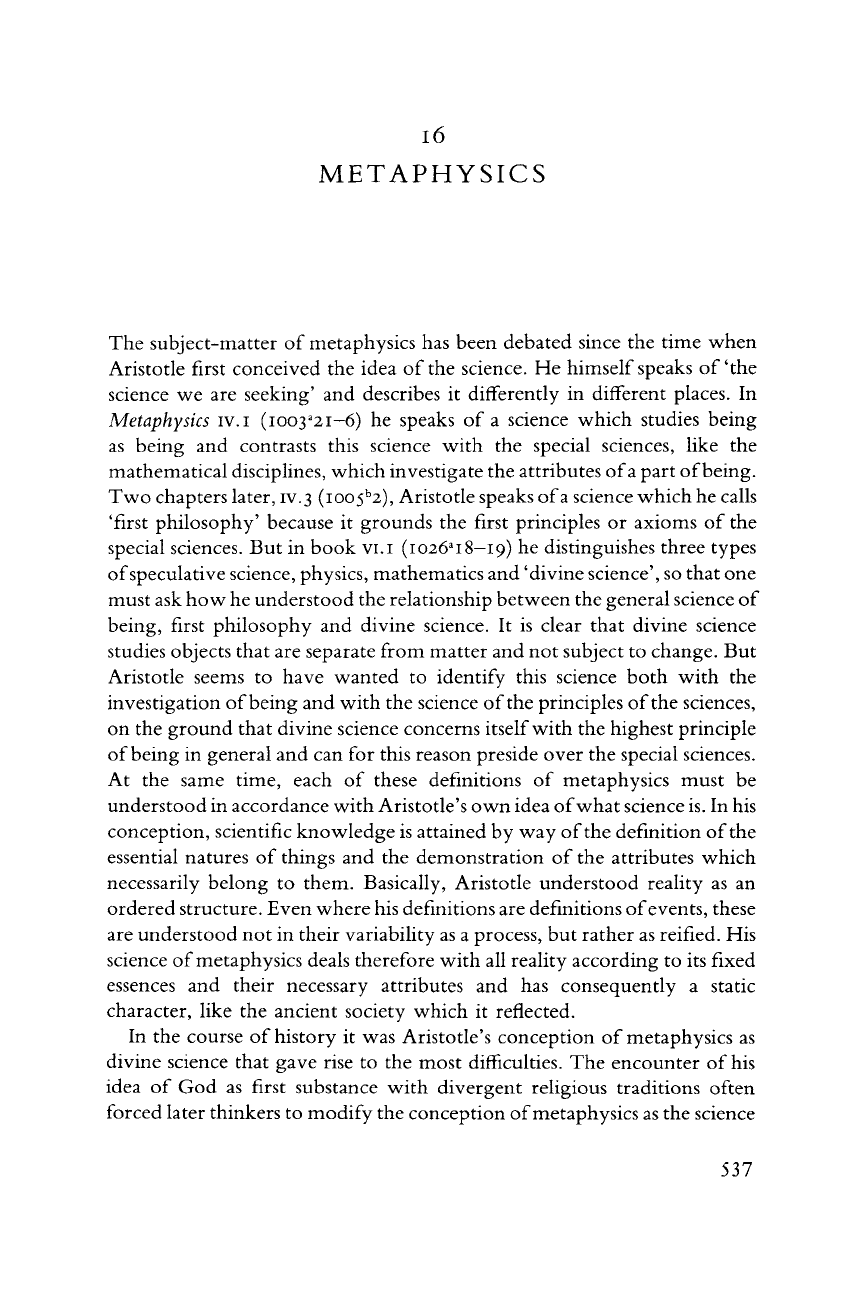
16
The
subject-matter of metaphysics has been debated since the time when
Aristotle
first conceived the idea of the science. He himself speaks of 'the
science
we are seeking' and describes it differently in different places. In
Metaphysics iv.i (ioo3
a
2i-6) he speaks of a science which studies being
as being and contrasts this science with the special sciences, like the
mathematical disciplines, which investigate the
attributes
of
a
part
of
being.
Two
chapters later, iv.3 (ioo5
b
2), Aristotle speaks
of
a science which he calls
'first philosophy' because it grounds the first principles or axioms of the
special
sciences. But in book
VI.I
(i026
a
i8—19) he distinguishes
three
types
of
speculative science, physics, mathematics and 'divine science', so
that
one
must ask how he understood the relationship between the general science of
being,
first philosophy and divine science. It is clear
that
divine science
studies objects
that
are separate from
matter
and not subject to change. But
Aristotle
seems to have wanted to identify this science both with the
investigation
of
being and with the science
of
the principles
of
the sciences,
on the ground
that
divine science concerns itself with the highest principle
of
being in general and can for this reason preside over the special sciences.
At
the same time, each of these definitions of metaphysics must be
understood in accordance with Aristotle's own idea
of
what science is. In his
conception, scientific knowledge is attained by way
of
the definition
of
the
essential
natures
of things and the demonstration of the
attributes
which
necessarily belong to them. Basically, Aristotle understood reality as an
ordered structure. Even where his definitions are definitions
of
events, these
are understood not in their variability as a process, but
rather
as reified. His
science
of
metaphysics deals therefore with all reality according to its fixed
essences and their necessary
attributes
and has consequently a static
character, like the ancient society which it reflected.
In the course of history it was Aristotle's conception of metaphysics as
divine science
that
gave rise to the most difficulties. The encounter of his
idea of God as first substance with divergent religious traditions often
forced
later thinkers to modify the conception
of
metaphysics as the science
537
METAPHYSICS
Cambridge Histories Online © Cambridge University Press, 2008
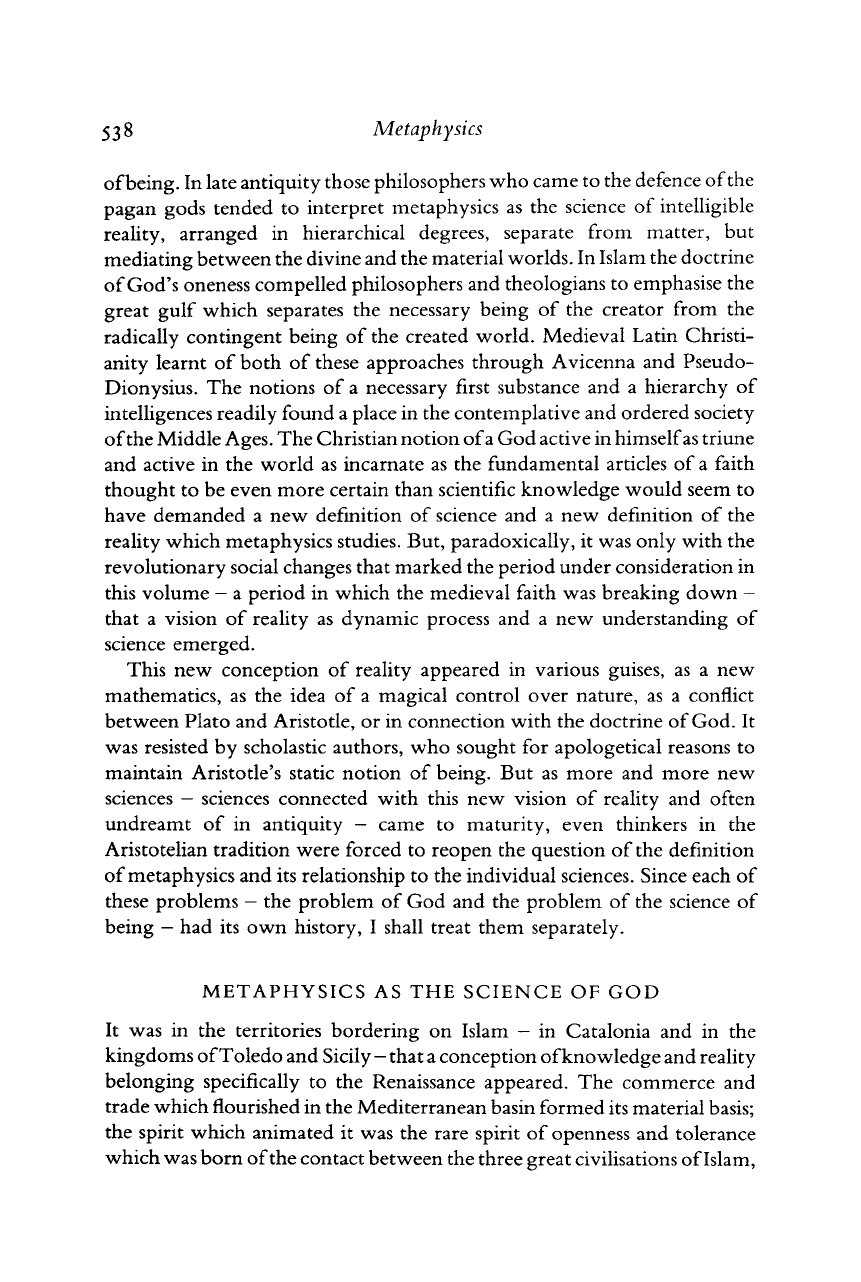
538
Metaphysics
of
being.
In late antiquity those philosophers who came to the defence
of
the
pagan gods tended to interpret metaphysics as the science of intelligible
reality, arranged in hierarchical degrees, separate from
matter,
but
mediating between the divine and the material worlds. In Islam the doctrine
of
God's
oneness compelled philosophers and theologians to emphasise the
great
gulf
which separates the necessary being of the creator from the
radically
contingent being of the created world. Medieval Latin Christi-
anity learnt of both of these approaches through Avicenna and Pseudo-
Dionysius.
The notions of a necessary first substance and a hierarchy of
intelligences
readily found a place in the contemplative and ordered society
of
the Middle
Ages.
The Christian notion
of
a God active in
himself
as
triune
and active in the world as incarnate as the fundamental articles of a faith
thought to be even more certain
than
scientific knowledge would seem to
have
demanded a new definition of science and a new definition of the
reality which metaphysics studies. But, paradoxically, it was only with the
revolutionary social changes
that
marked the period under consideration in
this volume
—
a period in which the medieval faith was breaking down
—
that
a vision of reality as dynamic process and a new understanding of
science
emerged.
This
new conception of reality appeared in various guises, as a new
mathematics, as the idea of a magical control over nature, as a conflict
between
Plato and Aristotle, or in connection with the doctrine of God. It
was
resisted by scholastic authors, who sought for apologetical reasons to
maintain Aristotle's static notion of being. But as more and more new
sciences
— sciences connected with this new vision of reality and often
undreamt of in antiquity — came to maturity, even thinkers in the
Aristotelian
tradition were forced to reopen the question of the definition
of
metaphysics and its relationship to the individual sciences. Since each of
these problems
—
the problem of God and the problem of the science of
being
—
had its own history, I shall
treat
them separately.
METAPHYSICS
AS THE
SCIENCE
OF GOD
It was in the territories bordering on Islam - in Catalonia and in the
kingdoms
of
Toledo
and
Sicily
-
that
a conception
of
knowledge
and reality
belonging
specifically to the Renaissance appeared. The commerce and
trade
which flourished in the Mediterranean basin formed its material basis;
the spirit which animated it was the
rare
spirit of openness and tolerance
which
was born
of
the contact between the
three
great civilisations
of
Islam,
Cambridge Histories Online © Cambridge University Press, 2008
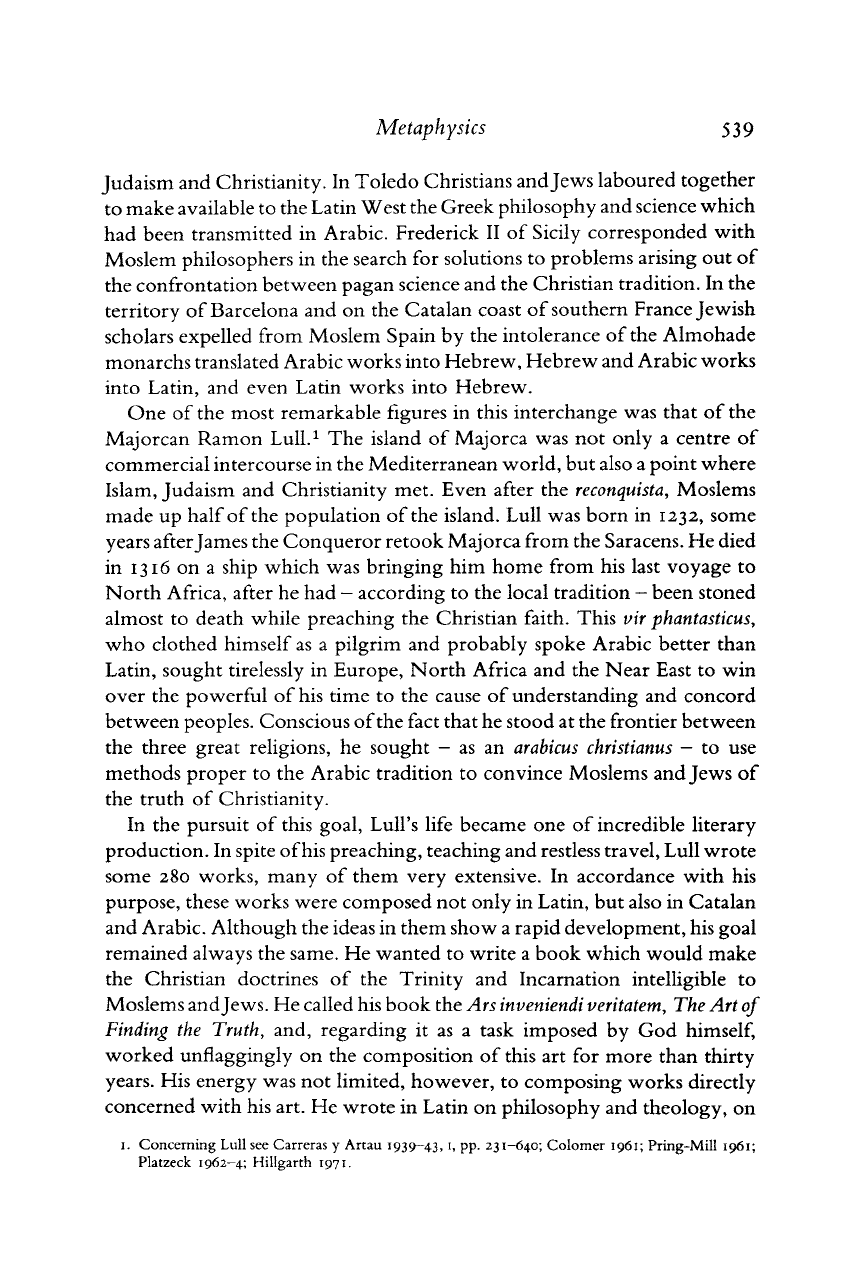
Metaphysics
539
Judaism
and Christianity. In Toledo Christians and Jews laboured together
to make available to the Latin West the Greek philosophy and science which
had been
transmitted
in Arabic. Frederick II of
Sicily
corresponded with
Moslem
philosophers in the search for solutions to problems arising out of
the confrontation between pagan science and the Christian tradition. In the
territory of Barcelona and on the Catalan coast of southern France Jewish
scholars expelled from Moslem Spain by the intolerance of the Almohade
monarchs translated Arabic works into Hebrew, Hebrew and Arabic works
into Latin, and even Latin works into Hebrew.
One
of the most remarkable figures in this interchange was
that
of the
Majorcan
Ramon
Lull.
1
The island of Majorca was not only a centre of
commercial
intercourse in the Mediterranean world, but also a point where
Islam,
Judaism
and Christianity met. Even after the reconquista, Moslems
made up half of the population of the island.
Lull
was born in 1232, some
years
after
James
the Conqueror retook Majorca from the Saracens. He died
in 1316 on a ship which was bringing him home from his last voyage to
North
Africa,
after he had - according to the local tradition - been stoned
almost to death while preaching the Christian faith. This vir phantasticus,
who
clothed himself as a pilgrim and probably spoke Arabic
better
than
Latin,
sought tirelessly in Europe, North
Africa
and the Near East to win
over
the powerful of his time to the cause of understanding and concord
between
peoples. Conscious
of
the fact
that
he stood at the frontier between
the
three
great religions, he sought — as an arabicus christianus — to use
methods proper to the Arabic tradition to convince Moslems and Jews of
the
truth
of Christianity.
In the pursuit of this goal, Lull's
life
became one of incredible literary
production. In spite
of
his preaching, teaching and restless travel,
Lull
wrote
some 280 works, many of them very extensive. In accordance with his
purpose, these works were composed not only in Latin, but also in Catalan
and Arabic. Although the ideas in them show a rapid development, his goal
remained always the same. He wanted to write a book which would make
the Christian doctrines of the Trinity and Incarnation intelligible to
Moslems
and
Jews.
He called his book the AYS inveniendi
veritatem,
The Art of
Finding
the Truth, and, regarding it as a task imposed by God himself,
worked
unflaggingly on the composition of this art for more
than
thirty
years.
His energy was not limited, however, to composing works directly
concerned with his art. He wrote in Latin on philosophy and theology, on
1.
Concerning
Lull
see
Carreras
y
Artau
1939-43,!>
PP-
231-640;
Colomer
1961;
Pring-Mill
1961;
Platzeck
1962-4;
Hillgarth
1971.
Cambridge Histories Online © Cambridge University Press, 2008
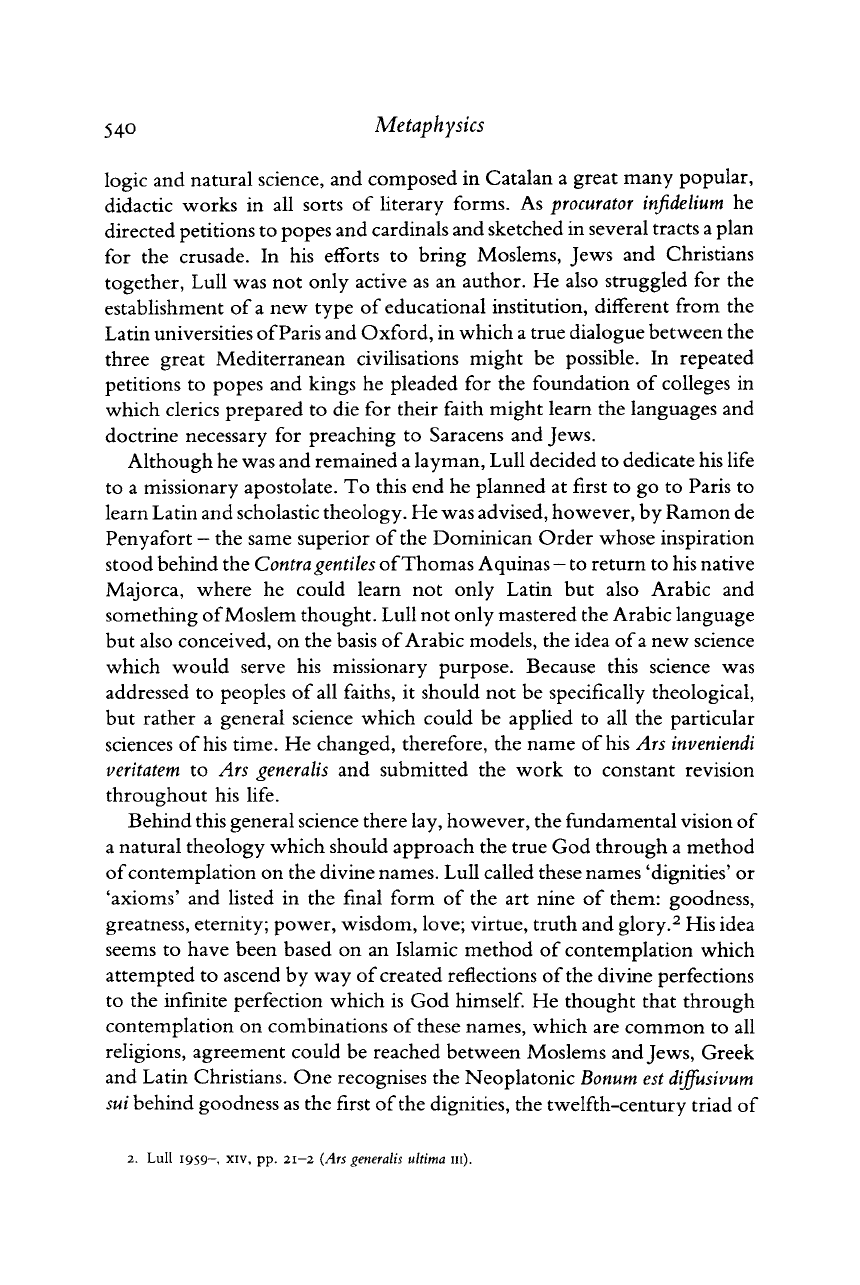
540
Metaphysics
logic
and
natural
science, and composed in Catalan a great many popular,
didactic works in all sorts of literary forms. As procurator injidelium he
directed petitions to popes and cardinals and sketched in several
tracts
a plan
for
the crusade. In his efforts to bring Moslems, Jews and Christians
together,
Lull
was not only active as an
author.
He also struggled for the
establishment of a new type of educational institution, different from the
Latin universities
of
Paris and Oxford, in which a
true
dialogue between the
three
great Mediterranean civilisations might be possible. In repeated
petitions to popes and kings he pleaded for the foundation of
colleges
in
which
clerics prepared to die for their faith might learn the languages and
doctrine necessary for preaching to Saracens and Jews.
Although
he was and remained a layman,
Lull
decided to dedicate his
life
to a missionary apostolate. To this end he planned at first to go to Paris to
learn Latin and scholastic theology. He was advised, however, by Ramon de
Penyafort - the same superior of the Dominican Order whose inspiration
stood behind the Contra gentiles
of
Thomas Aquinas
—
to
return
to his native
Majorca,
where he could learn not only Latin but also Arabic and
something
of
Moslem
thought.
Lull
not only mastered the Arabic language
but also conceived, on the basis
of
Arabic
models, the idea
of
a new science
which
would serve his missionary purpose. Because this science was
addressed to peoples of all faiths, it should not be specifically theological,
but
rather
a general science which could be applied to all the particular
sciences
of his time. He changed, therefore, the name of his Ars inveniendi
veritatem
to Ars generalis and submitted the work to constant revision
throughout his
life.
Behind this general science
there
lay, however, the fundamental vision of
a
natural
theology which should approach the
true
God through a method
of
contemplation on the divine names.
Lull
called these names 'dignities' or
'axioms'
and listed in the final form of the art nine of them: goodness,
greatness, eternity; power, wisdom,
love;
virtue,
truth
and glory.
2
His idea
seems to have been based on an Islamic method of contemplation which
attempted to ascend by way of created reflections
of
the divine perfections
to the infinite perfection which is God himself. He thought
that
through
contemplation on combinations of these names, which are common to all
religions,
agreement could be reached between Moslems and Jews, Greek
and Latin Christians. One recognises the Neoplatonic
Bonum
est
diffusivum
sui behind goodness as the first
of
the dignities, the twelfth-century
triad
of
2.
Lull
1959-,
xiv, pp. 21-2 (Ars generalis
ultima
m).
Cambridge Histories Online © Cambridge University Press, 2008
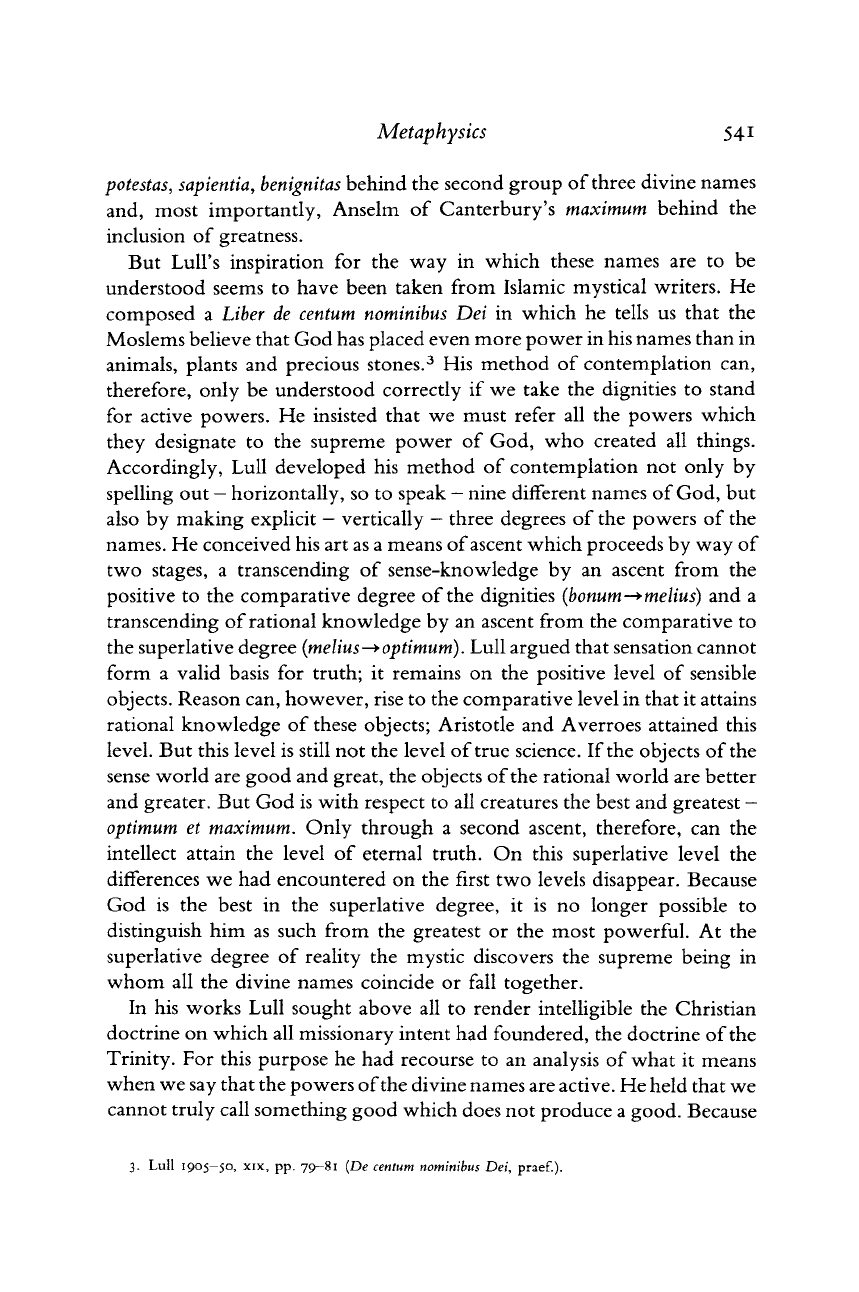
Metaphysics
54i
potestas, sapientia, benignitas behind the second group of
three
divine names
and, most importantly, Anselm of Canterbury's
maximum
behind the
inclusion of greatness.
But
Lull's inspiration for the way in which these names are to be
understood seems to have been taken from Islamic mystical writers. He
composed a Liber de centum nominibus Dei in which he tells us
that
the
Moslems
believe
that
God has placed even more power in his names
than
in
animals, plants and precious stones.
3
His method of contemplation can,
therefore, only be understood correctly if we take the dignities to stand
for
active powers. He insisted
that
we must refer all the powers which
they designate to the supreme power of God, who created all things.
Accordingly,
Lull
developed his method of contemplation not only by
spelling
out
—
horizontally, so to speak
—
nine different names of God, but
also by making explicit
—
vertically
—
three
degrees of the powers of the
names. He conceived his art as a means
of
ascent which proceeds by way of
two
stages, a transcending of sense-knowledge by an ascent from the
positive to the comparative degree of the dignities (bonum-^ melius) and a
transcending of rational knowledge by an ascent from the comparative to
the superlative degree (meliusoptimum).
Lull
argued
that
sensation cannot
form a valid basis for
truth;
it remains on the positive
level
of sensible
objects.
Reason can, however, rise to the comparative
level
in
that
it attains
rational knowledge of these objects; Aristotle and Averroes attained this
level.
But this
level
is still not the
level
of
true
science. If the objects of the
sense world are good and great, the objects of the rational world are better
and greater. But God is with respect to all creatures the best and greatest -
optimum
et
maximum.
Only through a second ascent, therefore, can the
intellect attain the
level
of eternal
truth.
On this superlative
level
the
differences
we had encountered on the first two levels disappear. Because
God
is the best in the superlative degree, it is no longer possible to
distinguish him as such from the greatest or the most powerful. At the
superlative degree of reality the mystic discovers the supreme being in
whom
all the divine names coincide or
fall
together.
In his works
Lull
sought above all to render intelligible the Christian
doctrine on which all missionary intent had foundered, the doctrine
of
the
Trinity. For this purpose he had recourse to an analysis of what it means
when we say
that
the powers
of
the divine names are active. He held
that
we
cannot truly call something good which does not produce a good. Because
3. Lull
1905-50,
xix, pp. 79-81 (De
centum
nominibus Dei,
praef.).
Cambridge Histories Online © Cambridge University Press, 2008
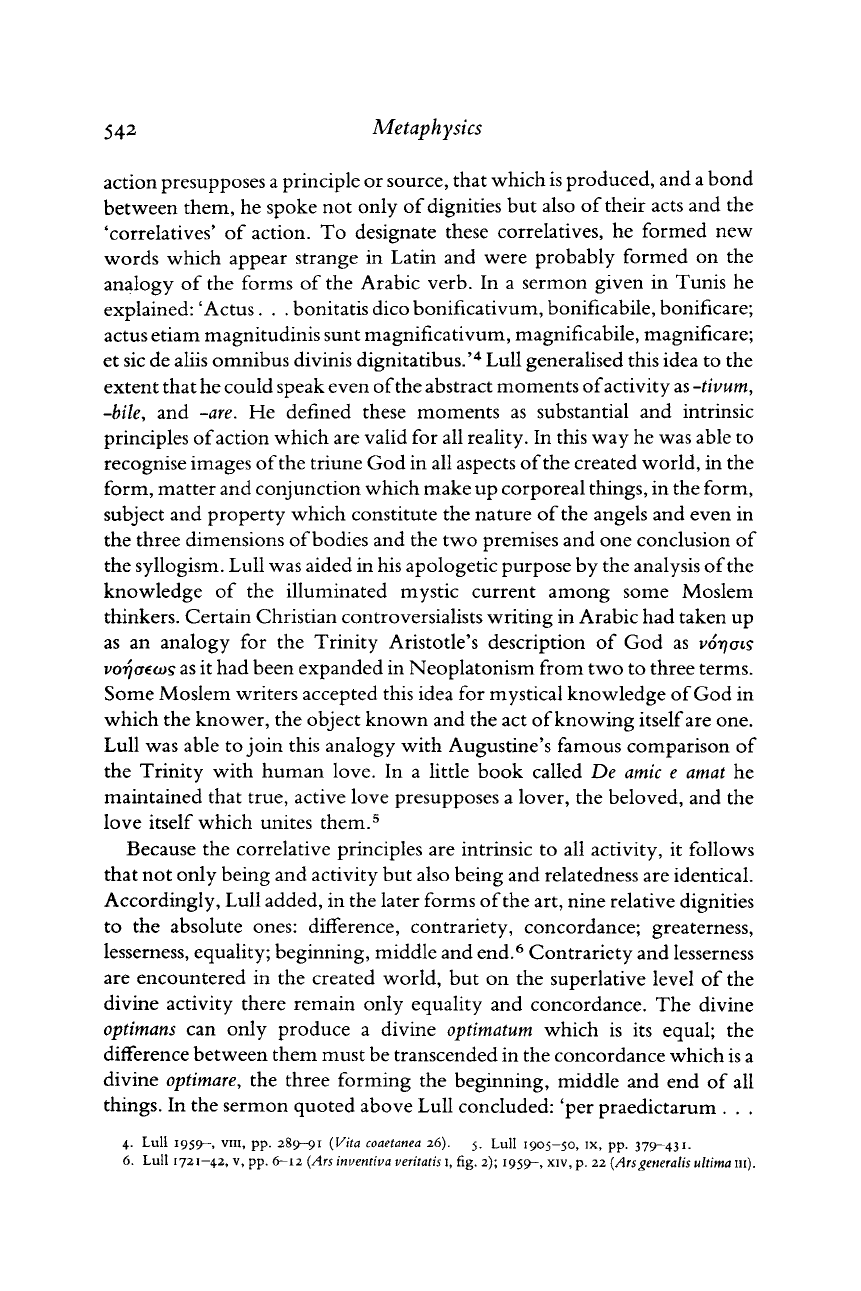
542
Metaphysics
action presupposes a principle or source,
that
which is produced, and a bond
between them, he spoke not only of dignities but also of their acts and the
'correlatives'
of action. To designate these correlatives, he formed new
words which appear strange in Latin and were probably formed on the
analogy
of the forms of the Arabic verb. In a sermon
given
in Tunis he
explained:
'Actus.
. . bonitatis dico bonificativum, bonificabile, bonificare;
actus etiam magnitudinis sunt magnificativum, magnificabile, magnificare;
et sic de aliis omnibus divinis dignitatibus.'
4
Lull
generalised this idea to the
extent
that
he could speak even
of
the abstract moments
of
activity
as
-tivum,
-bile,
and -are. He defined these moments as substantial and intrinsic
principles
of
action which are valid for all reality. In this way he was able to
recognise images
of
the
triune
God in all aspects
of
the created world, in the
form, matter and conjunction which make up corporeal things, in the form,
subject and property which constitute the
nature
of the angels and even in
the
three
dimensions
of
bodies and the two premises and one conclusion of
the
syllogism.
Lull
was aided in his apologetic purpose by the analysis
of
the
knowledge
of the illuminated mystic current among some Moslem
thinkers. Certain Christian controversialists writing in Arabic had taken up
as an analogy for the Trinity Aristotle's description of God as vo-qois
vorjaeojs as it had been expanded in Neoplatonism from two to
three
terms.
Some
Moslem writers accepted this idea for mystical knowledge
of
God
in
which
the knower, the object known and the act
of
knowing
itself
are one.
Lull
was able to join this analogy with Augustine's famous comparison of
the Trinity with human
love.
In a little book called De amic e
amat
he
maintained
that
true, active
love
presupposes a lover, the beloved, and the
love
itself which unites them.
5
Because
the correlative principles are intrinsic to all activity, it
follows
that
not only being and activity but also being and relatedness are identical.
Accordingly,
Lull
added, in the later forms
of
the art, nine relative dignities
to the absolute ones: difference, contrariety, concordance; greaterness,
lesserness, equality; beginning, middle and end.
6
Contrariety and lesserness
are encountered in the created world, but on the superlative
level
of the
divine activity
there
remain only equality and concordance. The divine
optimans can only produce a divine
optimatum
which is its equal; the
difference between them must be transcended in the concordance which is a
divine optimare, the
three
forming the beginning, middle and end of all
things. In the sermon quoted above
Lull
concluded: 'per praedictarum . . .
4. Lull
1959-,
VIII,
pp.
289-91
(Vita coaetanea 26). 5. Lull
1905-50,
ix, pp.
379-431.
6. Lull 1721-42, v, pp. 6-12 (Ars
inventiva
veritatis
1, fig. 2);
1959-,
xiv, p. 22 (Arsgeneralis ultima in).
Cambridge Histories Online © Cambridge University Press, 2008
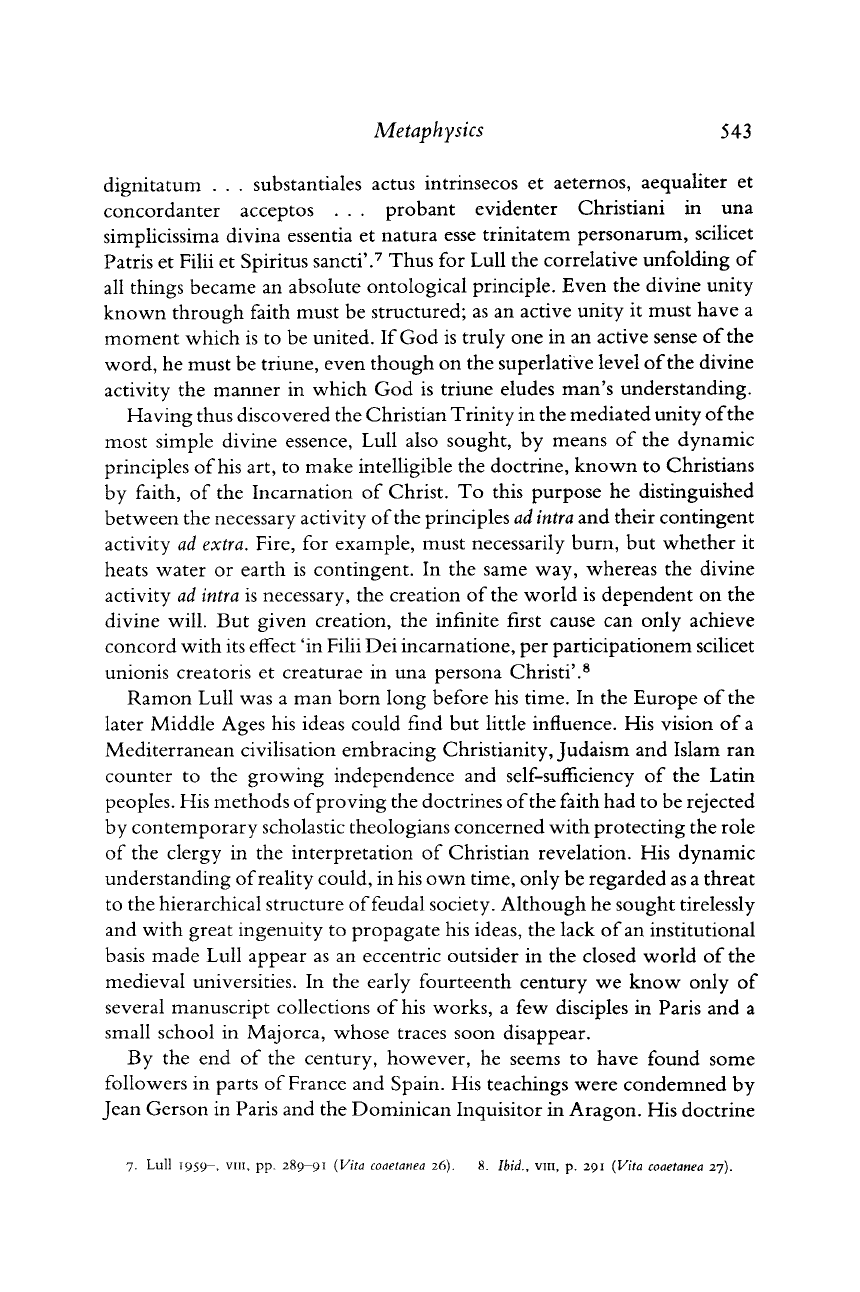
Metaphysics
543
dignitatum . . . substantiales actus intrinsecos et aeternos, aequaliter et
concordanter acceptos . . . probant evidenter Christiani in una
simplicissima
divina essentia et
natura
esse trinitatem personarum, scilicet
Patris et
Filii
et Spiritus sancti'.
7
Thus for
Lull
the correlative unfolding of
all
things became an absolute ontological principle. Even the divine unity
known
through faith must be structured; as an active unity it must have a
moment which is to be united. If God is truly one in an active sense of the
word,
he must be triune, even though on the superlative
level
of
the divine
activity
the manner in which God is
triune
eludes man's understanding.
Having
thus
discovered the Christian Trinity in the mediated unity
of
the
most simple divine essence,
Lull
also sought, by means of the dynamic
principles of his art, to make intelligible the doctrine, known to Christians
by
faith, of the Incarnation of Christ. To this purpose he distinguished
between
the necessary activity
of
the principles ad intra and their contingent
activity
ad extra. Fire, for example, must necessarily burn, but whether it
heats water or earth is contingent. In the same way, whereas the divine
activity
ad intra is necessary, the creation of the world is dependent on the
divine
will.
But
given
creation, the infinite first cause can only achieve
concord
with its
effect
'in
Filii
Dei incarnatione, per participationem scilicet
unionis creatoris et creaturae in una persona Christi'.
8
Ramon
Lull
was a man born long before his time. In the Europe of the
later Middle
Ages
his ideas could find but little influence. His vision of a
Mediterranean civilisation embracing Christianity, Judaism and Islam ran
counter to the growing independence and self-sufficiency of the Latin
peoples.
His methods
of
proving
the doctrines
of
the faith had to be rejected
by
contemporary scholastic theologians concerned with protecting the role
of
the clergy in the interpretation of Christian revelation. His dynamic
understanding
of
reality could, in his own time, only be regarded as a
threat
to the hierarchical structure
of
feudal
society. Although he sought tirelessly
and with great ingenuity to propagate his ideas, the lack of an institutional
basis made
Lull
appear as an eccentric outsider in the closed world of the
medieval
universities. In the early fourteenth century we know only of
several
manuscript collections of his works, a few disciples in Paris and a
small
school in Majorca, whose traces soon disappear.
By
the end of the century, however, he seems to have found some
followers
in
parts
of France and Spain. His teachings were condemned by
Jean
Gerson in Paris and the Dominican Inquisitor in Aragon. His doctrine
7. Lull 1959- vm, pp.
289-91
(Vita coaetanea 26). 8. Ibid., vm, p. 291 (Vita coaetanea 27).
Cambridge Histories Online © Cambridge University Press, 2008
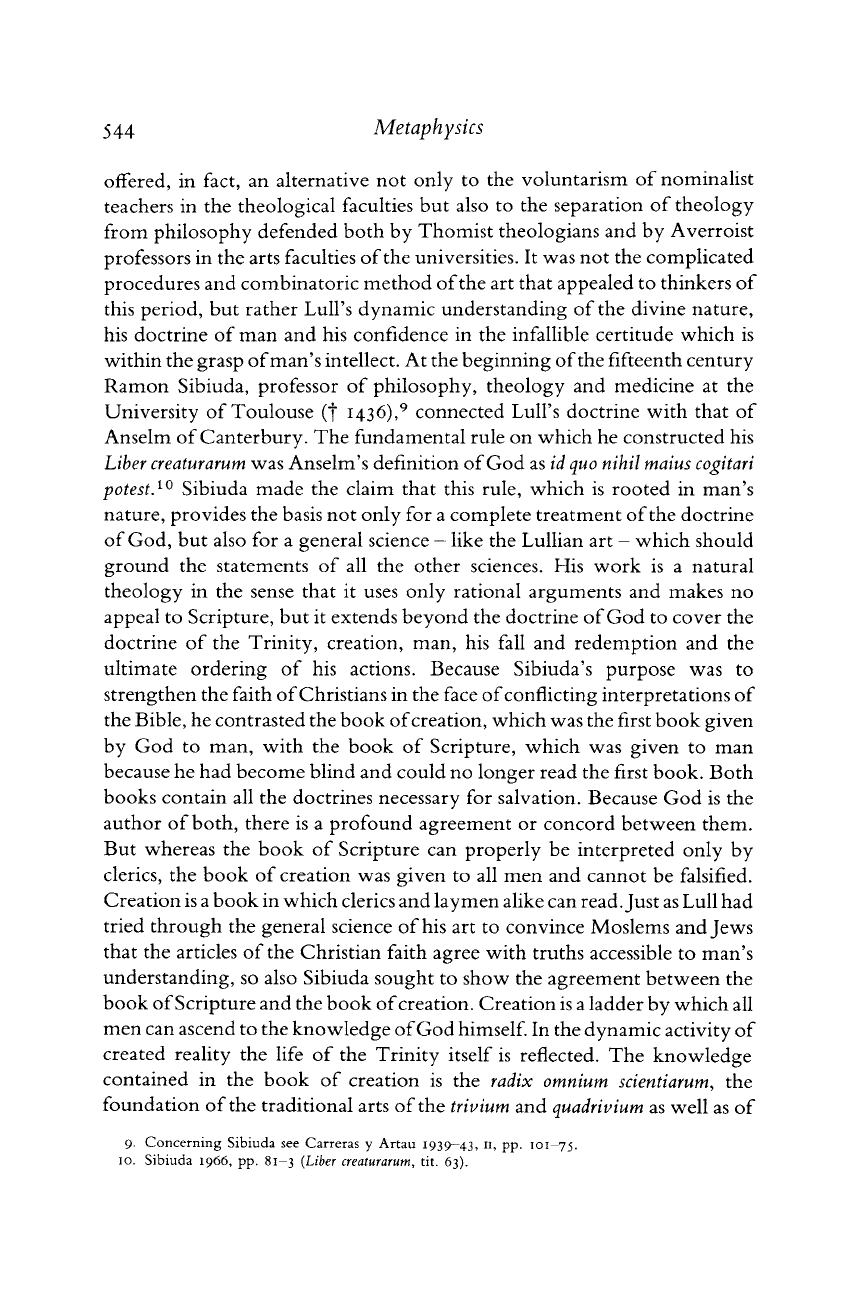
544
Metaphysics
offered,
in fact, an alternative not only to the voluntarism of nominalist
teachers in the theological faculties but also to the separation of theology
from
philosophy defended both by Thomist theologians and by Averroist
professors in the
arts
faculties
of
the universities. It was not the complicated
procedures and combinatoric method
of
the art
that
appealed to thinkers of
this period, but
rather
Lull's dynamic understanding of the divine nature,
his doctrine of man and his confidence in the infallible certitude which is
within the grasp
of
man's intellect. At the beginning
of
the fifteenth century
Ramon Sibiuda, professor of philosophy, theology and medicine at the
University
of Toulouse (f
1436),
9
connected Lull's doctrine with
that
of
Anselm
of Canterbury. The fundamental rule on which he constructed his
Liber
creaturarum was Anselm's definition
of
God
as id quo nihil maius cogitari
potest.
10
Sibiuda made the claim
that
this rule, which is rooted in man's
nature, provides the basis not only for a complete treatment
of
the doctrine
of
God, but also for a general science
—
like the Lullian art
—
which should
ground the statements of all the other sciences. His work is a natural
theology
in the sense
that
it uses only rational arguments and makes no
appeal to Scripture, but it extends beyond the doctrine
of
God
to cover the
doctrine of the Trinity, creation, man, his
fall
and redemption and the
ultimate ordering of his actions. Because Sibiuda's purpose was to
strengthen the faith
of
Christians in the face
of
conflicting
interpretations of
the
Bible,
he contrasted the book
of
creation, which was the first book given
by
God to man, with the book of Scripture, which was given to man
because he had become blind and could no longer read the first book. Both
books
contain all the doctrines necessary for salvation. Because God is the
author of both,
there
is a profound agreement or concord between them.
But
whereas the book of Scripture can properly be interpreted only by
clerics,
the book of creation was given to all men and cannot be falsified.
Creation
is a book in which clerics and laymen alike can readjust as
Lull
had
tried through the general science of his art to convince Moslems and Jews
that
the articles of the Christian faith agree with
truths
accessible to man's
understanding, so also Sibiuda sought to show the agreement between the
book
of
Scripture and the book
of
creation. Creation is a ladder by which all
men can ascend to the knowledge
of
God
himself. In the dynamic activity of
created reality the
life
of the Trinity itself is reflected. The knowledge
contained in the book of creation is the radix
omnium
scientiarum, the
foundation of the traditional
arts
of the
trivium
and
quadrivium
as
well
as of
9.
Concerning
Sibiuda
see
Carreras
y
Artau
1939-43,
n. PP- 101-75.
10.
Sibiuda
1966, pp. 81-3 (Liber creaturarum, tit. 63).
Cambridge Histories Online © Cambridge University Press, 2008
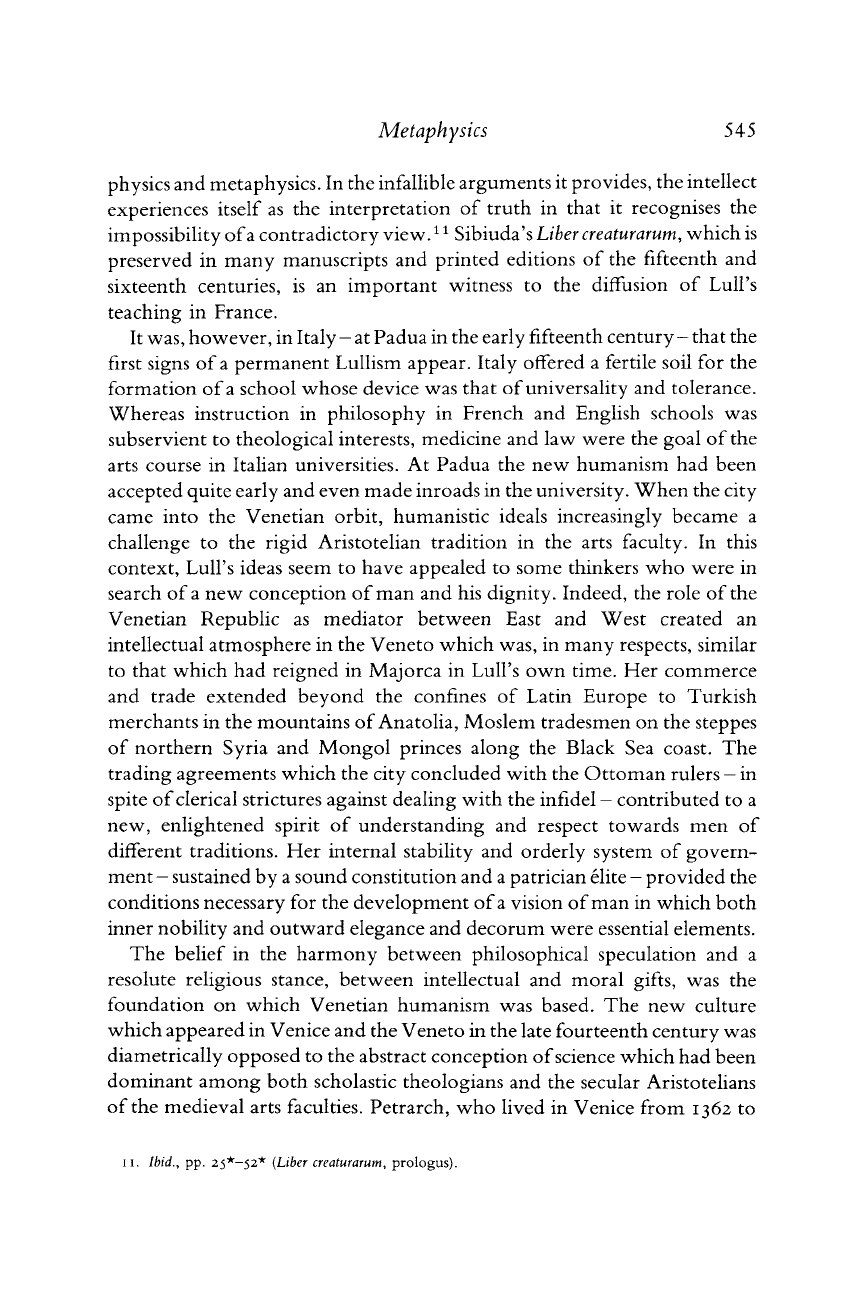
Metaphysics
545
physics
and metaphysics. In the infallible arguments it provides, the intellect
experiences itself as the
interpretation
of
truth
in
that
it recognises the
impossibility
of
a contradictory
view.
11
Sibiuda's Liber
creaturarum,
which is
preserved in many manuscripts and
printed
editions of the fifteenth and
sixteenth centuries, is an
important
witness to the diffusion of Lull's
teaching in France.
It was, however, in Italy - at Padua in the early fifteenth century -
that
the
first signs of a
permanent
Lullism appear. Italy offered a fertile soil for the
formation of a school whose device was
that
of
universality and tolerance.
Whereas instruction in philosophy in French and English schools was
subservient to theological interests, medicine and law were the goal of the
arts
course in Italian universities. At Padua the new humanism had been
accepted quite early and even made inroads in the university. When the city
came into the Venetian orbit, humanistic ideals increasingly became a
challenge to the rigid Aristotelian tradition in the
arts
faculty. In this
context, Lull's ideas seem to have appealed to some thinkers who were in
search of a new conception of man and his dignity. Indeed, the role of the
Venetian
Republic as mediator between East and West created an
intellectual atmosphere in the Veneto which was, in many respects, similar
to
that
which had reigned in Majorca in Lull's own time. Her commerce
and
trade
extended beyond the confines of Latin Europe to Turkish
merchants in the mountains
of
Anatolia,
Moslem tradesmen on the steppes
of
northern
Syria and Mongol princes along the
Black
Sea coast. The
trading agreements which the city concluded with the Ottoman rulers
—
in
spite
of
clerical
strictures against dealing with the infidel
—
contributed to a
new, enlightened spirit of understanding and respect towards men of
different traditions. Her internal stability and orderly system of govern-
ment
—
sustained by a sound constitution and a patrician elite
—
provided the
conditions necessary for the development
of
a vision
of
man in which both
inner nobility and outward elegance and decorum were essential elements.
The
belief
in the harmony between philosophical speculation and a
resolute religious stance, between intellectual and moral
gifts,
was the
foundation on which Venetian humanism was based. The new culture
which
appeared in
Venice
and the Veneto in the late fourteenth century was
diametrically opposed to the abstract conception
of
science
which had been
dominant among both scholastic theologians and the secular Aristotelians
of
the medieval
arts
faculties. Petrarch, who
lived
in
Venice
from 1362 to
11.
Ibid., pp.
25*—52*
(Liber
creaturarum,
prologus).
Cambridge Histories Online © Cambridge University Press, 2008
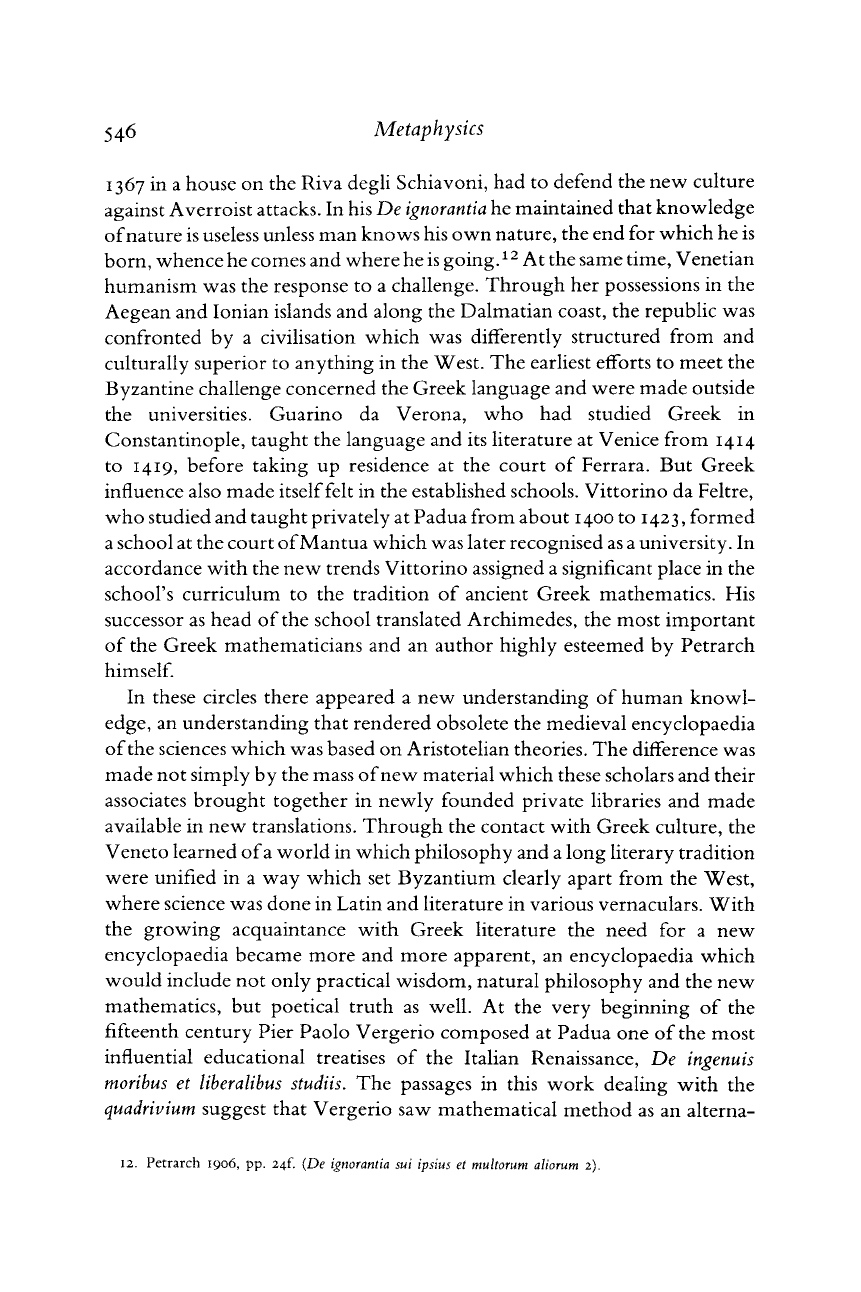
546
Metaphysics
1367
in a house on the Riva degli Schiavoni, had to defend the new culture
against Averroist attacks. In his De ignorantia he maintained
that
knowledge
of
nature
is useless unless man knows his own nature, the end for which he is
born, whence he comes and where he is going.
12
At the same time, Venetian
humanism was the response to a challenge. Through her possessions in the
Aegean
and Ionian islands and along the Dalmatian coast, the republic was
confronted by a civilisation which was differently structured from and
culturally superior to anything in the West. The earliest efforts to meet the
Byzantine
challenge concerned the Greek language and were made outside
the universities. Guarino da Verona, who had studied Greek in
Constantinople, taught the language and its literature at Venice from 1414
to 1419, before taking up residence at the court of Ferrara. But Greek
influence also made
itself
felt
in the established schools. Vittorino da Feltre,
who
studied and taught privately at Padua from about 1400 to 1423, formed
a school at the court
of
Mantua which was later recognised as a university. In
accordance with the new
trends
Vittorino assigned a significant place in the
school's
curriculum to the tradition of ancient Greek mathematics. His
successor as head of the school translated Archimedes, the most important
of
the Greek mathematicians and an author highly esteemed by Petrarch
himself.
In these circles
there
appeared a new understanding of human knowl-
edge,
an understanding
that
rendered obsolete the medieval encyclopaedia
of
the sciences which was based on Aristotelian theories. The difference was
made not simply by the mass
of
new material which these scholars and their
associates brought together in newly founded private libraries and made
available
in new translations. Through the contact with Greek culture, the
Veneto
learned
of
a world in which philosophy and a long literary tradition
were unified in a way which set Byzantium clearly
apart
from the West,
where science was done in Latin and literature in various vernaculars. With
the growing acquaintance with Greek literature the need for a new
encyclopaedia
became more and more apparent, an encyclopaedia which
would
include not only practical wisdom, natural philosophy and the new
mathematics, but poetical
truth
as
well.
At the very beginning of the
fifteenth century Pier Paolo Vergerio composed at Padua one of the most
influential educational treatises of the Italian Renaissance, De ingenuis
moribus et liberalibus studiis. The passages in this work dealing with the
quadrivium
suggest
that
Vergerio saw mathematical method as an alterna-
12.
Petrarch
1906, pp. 2^. (De ignorantia sui ipsius et
multorum
aliorum 2).
Cambridge Histories Online © Cambridge University Press, 2008
